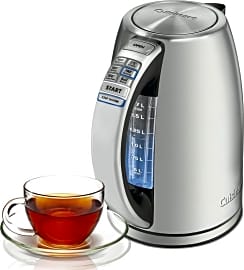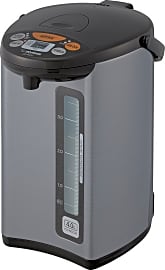The 10 Best Tea Kettles

This wiki has been updated 41 times since it was first published in May of 2015. From the simple and functional to the sleek and stylish, our selection of tea kettles offers something for everyone. With a wide range of both stovetop and electric models, whether you want a fast cup before heading out or like to take your time and relax over a brew steeped at the perfect temperature, we've got you covered. You'll find designs and prices to suit any taste. When users buy our independently chosen editorial picks, we may earn commissions to help fund the Wiki.
Editor's Notes
January 14, 2020:
Helpful for making everything from tea and coffee to oatmeal and instant soup, a quality kettle is one of the most versatile items one can have in their kitchen. For this list, our priorities included smart, thoughtful designs, easy-grip handles and cool-touch features, precise pour spouts, wide bases, even heating, easy cleaning, and high-quality materials. We also wanted to strike a balance between electric and traditional options.
When we took stock during this recent update, we noticed there were few glass options, and so added the Cafe Brew Collection. Glass is an ideal solution for people who don't like the idea of boiling water in stainless steel or plastic kettles for fear of leaching chemicals, with the additional benefit that it's elegant and transparent, so you can keep track of your water levels easily. The Cafe Brew model is well made and priced very attractively, but remember that even though it's tough, it's still glass. Don't leave it in the sink, set it down on countertops with force, or put it straight into the fridge from the stove without letting it cool. Also be sure to follow instructions, as glass must be used and cared for in a particular way.
Many people are tempted to put stovetop kettles, like the KitchenAid Stainless Steel and Oxo Good Grips Classic, on high heat so they will boil quicker, but this causes damage. Unless directed otherwise, only use stovetop kettles over medium-heat and never on a cooktop they aren't intended for, like induction.
Today we said goodbye to the All-Clad Specialty, which suffered from quality complaints, and the Better Houseware Collapsible, which became unavailable. We added the top of the line, high-tech Fellow Stagg EKG and reliable Cafe Brew Collection in their stead. The Stagg EKG is perfect for people who take their coffee and tea very seriously, as it can reach precise temperatures and has a built-in stopwatch so you can time your extractions to the second.
One more thing we'd like to note: stainless steel is susceptible to rusting under specific conditions. The best way to combat this is to regularly wash your kettle and dry it completely. If you do notice rust, you can use vinegar and boiling water to remove it. Use a 1:1 ratio, boil for a few minutes, then empty. After that, wash your kettle thoroughly per the manufacturer's instructions.
Special Honors
Smeg x Dolce & Gabbana Sicily Is My Love Lovers of designer pieces will appreciate this electric offering from Smeg and Dolce & Gabbana, which is decorated with Sicilian cart motifs, colorful patterns, and shapes depicting Mediterranean flavors. The stainless steel body sports a powder coat for durability, while the polished chrome base and stainless steel ball lever knob and spout add a contemporary touch. It has a soft-open lid, auto-shutoff function, removable limescale filter, 360-degree swivel base, and a concealed heating element. smegusa.com
Simplex Buckingham No.3 Handcrafted in England using traditional techniques, the Simplex Buckingham No.3 features a distinctive whistle, solid copper body, and mirror-finished chrome-plated exterior that complements many kitchen decors. It is lead-free, has a bird's mouth spout for an even pour, and a stay-cool solid beechwood handle. Maintenance is easy, as you simply need to hand wash it with non-abrasive detergents and dry it with a soft cloth. neweybloomer.com
Comforting Rituals
Very little in the world can compare to the soothing qualities of a good cup of tea.
After water, tea is the most widely consumed beverage in the world, and for good reason. Very little in the world can compare to the soothing qualities of a good cup of tea. Conversely, the caffeine levels in certain teas allow us to function at a higher level than coffee can, as long as you aren't comparing it to some latte with five shots of espresso and a cup of sugar in it.
The energizing effects of tea are easy to trace. Xanthines like caffeine and theophylline in tea act as a stimulant to the central nervous system, increasing heart rate and focus. The active ingredients which reduce stress and provide the soothing characteristics of tea are a little harder to identify.
Tea is an extraordinarily complex drink, full of flavonoids, catechins, amino acids, and polyphenols, all of which could have a marked affect on brain activity and corresponding levels of cortisol, the stress hormone. That is all, of course, ignoring the ritual of tea making, which has its own kind of soothing property as well.
Regardless of where you look throughout the history of man, in even the most remote and isolated pockets of antiquated humanity, there is ritual. Repeated actions performed with or without the conscious attempt at achieving spiritual or physical levity exist in each of our lives, and the brewing of tea is among them. These actions provide an undeniable sense of comfort from their repetitiveness, from their reliability.
Any of the tea kettles on our list could easily become a part of your tea ritual, whether you end up with an electric kettle or a stove top model. Many electric kettles heat water by the same means, which is through an electric coil that converts voltage into heat as the energy from the outlet excites the metal of the coil. That heat transfers through an insulated metal plate at the bottom of the kettle and heats the water within.
Stove top models are a little more traditional, as they use the heat from your stove's flame to transfer energy into the water they hold, heating it up the more it gets excited, eventually bringing it to a boil.
In Hot Water
Proper tea making is a pretty delicate process, especially according to the purists out there. Different teas and tea blends require different steeping times in different temperatures of water. Even in England, a country known and often lampooned for its tea consumption, the average citizen reportedly makes a pretty bad cup of tea.
Most people agree that electric models boil water a little bit faster than you can on the stove, so if efficiency is your priority, electric is the way to go.
Whatever your level of adherence to the stipulations set forth by tea aficionados, having the right kettle in your life will at least get your water hot in a way that pleases you, and making that first step toward tea preparation a positive psychological one will have a remarkable effect on the rest of the process and, undoubtedly, on the flavor of the tea.
The main thing you need to ask yourself is whether you want to go with a traditional stove top tea kettle or an electric model. Most people agree that electric models boil water a little bit faster than you can on the stove, so if efficiency is your priority, electric is the way to go. The electric kettles on our list also offer you specific temperature cut-offs, so that you can get your water up to a preferred temperature for a certain type of tea that might burn if you hit it with boiling water.
The advantages of the stove top kettles are mostly aesthetic, as they can more easily be stored without having to deal with any cords, or they can attractively live on your range while you're not using them. If you have limited counter space, or if you prefer the look of a more traditional tea kettle, these are your best bet.
Tea Time: A History Of The Brew
The history of the tea kettle is tied inexorably to the history of tea. The only problem with the history of tea is that its exact origins are something of a mystery. There are myths and traditions that purport one founder or another, sometimes mystical or violent, and other times simple and reasonable.
The emperor drank the mixture, and tea as we know it was founded.
In one example, the Buddha sat in meditation for the length of seven years when he suddenly fell asleep. Upon waking, he was so upset with his human weakness, with his inability to stay awake, that he cut off his eyelids and cast them to the earth. There, the eyelids took root and grew into the first tea tree. Considering the fact that tea was cultivated from an early age as a means of increasing its drinker's energy, it's interesting that its origin myth should have to do with staying awake.
In another tale, this one from ancient China, an emperor sat in his garden, contemplating the foliage and waiting for his water to boil. At the time, due to an outbreak of a certain water-born illness, the whole region boiled their water before consuming it. As he sat, a few dried leaves that had fallen from a nearby tree got swept up in a breeze and landed in his water, immediately discoloring it and producing a favorable aroma. The emperor drank the mixture, and tea as we know it was founded.
Whatever the actual origins of the drink, its propagation from China and India out through the tentacle reach of the British Empire made tea a worldwide phenomenon by the 19th century, and its popularity has grown like a sprout from an eyelid ever since.















